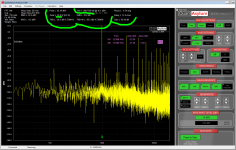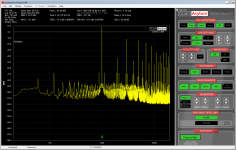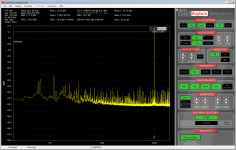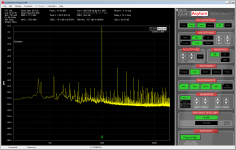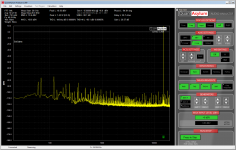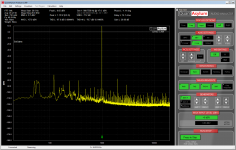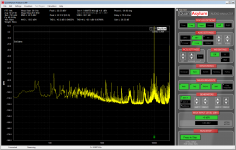Myles,
Zman is absolutely right.
These very small caps are critical in the design since they confer stability.
These caps operate at up to MHz to keep the amp (the AN has unity loop gain at about 460KHz) and at this frequency it must hold correct capacitance at the specified 10pF.)
Silver mica is the go, although X7 ceramic is OK too.
Cheers,
Hugh
Zman is absolutely right.
These very small caps are critical in the design since they confer stability.
These caps operate at up to MHz to keep the amp (the AN has unity loop gain at about 460KHz) and at this frequency it must hold correct capacitance at the specified 10pF.)
Silver mica is the go, although X7 ceramic is OK too.
Cheers,
Hugh
mica cap at C125
Thanks Hugh & Zman,
This following Mouser Mica cap should work just fine: 598-CD15CD100DO3-F from Cornell Dubilier
I tried to inert link about 4 times, it kept inserting the word "Nymeria" in the url, and it would not work. Sorry
This is one of the options listed for C125, C1250, in the schematic in Post #1551.
Please correct me if I am off base here.
Thanks,
MM
Thanks Hugh & Zman,
This following Mouser Mica cap should work just fine: 598-CD15CD100DO3-F from Cornell Dubilier
I tried to inert link about 4 times, it kept inserting the word "Nymeria" in the url, and it would not work. Sorry
This is one of the options listed for C125, C1250, in the schematic in Post #1551.
Please correct me if I am off base here.
Thanks,
MM
Last edited:
By the way no drama on power up of boards, I have to admit I was a little concerned. Initial power up of the Nirvana on my bench supply was able to provide 1khz test tone from N3 player ( again thanks X) - nice clean waveform on scope, clips where it should and light indicates. Ran it close to max output into heat sinks for 20 minutes main heat sink cooled down from idling temps. Gave a brief listening test bass was well controlled , the highs may need a little burn in time and my test bench connections all need to be cleaned as I do have a little cracking noice when switches and connection moved.
Bill
Nice work, Bill. Looking forward to seeing the amps all finished.
Grounding the three case
I will start with input ground and speaker grounds tied to their designated pins on the Alpa board ,and run the pe ground to the case and on the fourth wire on the power umbilical cord coming from the power supplies and tie it to a star ground on that case. I will try a nice wall wort for the fans and temp controller boards on a separate plug. I would like some sort of safety if the temps go to high, maybe something elegant that would roll the bias back, unless any of you may have a better idea. I do not have any fancy RG wire for input wire so will start with some shielded mic cable, my aim is for a really quite amp.
Bill
I will start with input ground and speaker grounds tied to their designated pins on the Alpa board ,and run the pe ground to the case and on the fourth wire on the power umbilical cord coming from the power supplies and tie it to a star ground on that case. I will try a nice wall wort for the fans and temp controller boards on a separate plug. I would like some sort of safety if the temps go to high, maybe something elegant that would roll the bias back, unless any of you may have a better idea. I do not have any fancy RG wire for input wire so will start with some shielded mic cable, my aim is for a really quite amp.
Bill
I managed to do some measurements of my build of AN,
using QA401 audio analyzer. PSU at +/- 20V.
Results below.
For some reason, noise floor in my setup seems to be very high.
1st screen shows noise floor with no signal.
It's not amp's fault; all amps I tried to measure show this..
Even without power applied to the amp, this noise is till there...
So all this noise can be discarded, and we need to pay attention to the numbers reported, and general level/shape of the plots.
Here is a link to similar measurements of another amp, to compare.
using QA401 audio analyzer. PSU at +/- 20V.
Results below.
For some reason, noise floor in my setup seems to be very high.
1st screen shows noise floor with no signal.
It's not amp's fault; all amps I tried to measure show this..
Even without power applied to the amp, this noise is till there...
So all this noise can be discarded, and we need to pay attention to the numbers reported, and general level/shape of the plots.
Here is a link to similar measurements of another amp, to compare.
Attachments
-
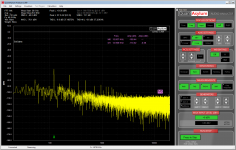 noise_floor_no_signal.png146.2 KB · Views: 400
noise_floor_no_signal.png146.2 KB · Views: 400 -
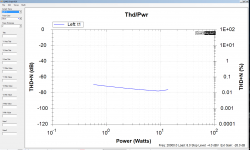 thd_power_20khz.png61.4 KB · Views: 112
thd_power_20khz.png61.4 KB · Views: 112 -
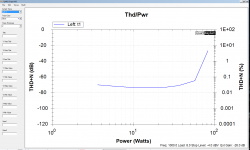 thd_power_1khz.png60.6 KB · Views: 107
thd_power_1khz.png60.6 KB · Views: 107 -
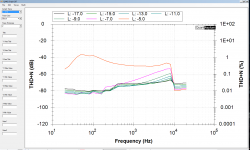 thd_frequency.png67.1 KB · Views: 112
thd_frequency.png67.1 KB · Views: 112 -
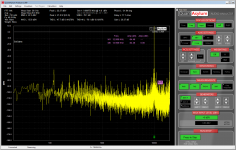 21W_10khz.png148.4 KB · Views: 100
21W_10khz.png148.4 KB · Views: 100 -
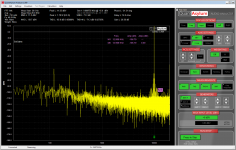 11W_10khz.png146.7 KB · Views: 93
11W_10khz.png146.7 KB · Views: 93 -
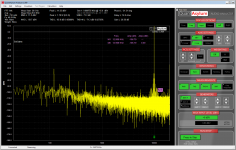 2W_10kHz.png146.7 KB · Views: 366
2W_10kHz.png146.7 KB · Views: 366 -
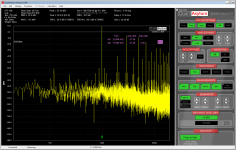 20W.png150.6 KB · Views: 374
20W.png150.6 KB · Views: 374 -
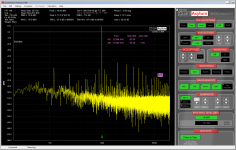 11W.png147.2 KB · Views: 391
11W.png147.2 KB · Views: 391 -
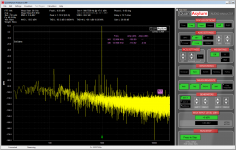 1W.png147.2 KB · Views: 393
1W.png147.2 KB · Views: 393
Last edited:
To get the noise floor down, set the average to 50
Select dBr peak to set your noise and distortion components to the output level.
Select dBr peak to set your noise and distortion components to the output level.
Last edited:
Hi Minek,
Can you tell us the conditions for the data - power (or Vpp) and load impedance etc?
It looks like you got about 50w before the distortion started rising? From +/-20v doesn’t make sense?
Can you tell us the conditions for the data - power (or Vpp) and load impedance etc?
It looks like you got about 50w before the distortion started rising? From +/-20v doesn’t make sense?
You can see power ratings, load impedance, signal freq, etc in each plot (images #1..#7, on top).
Also - if you move mouse over each image, browser will display (in the status bar) a tooltip with filename, which shows power and freq.
That's why I didn't repeat this information in the post.
In my case, usable power ranged from 0-20W. Above 20W thd is too high.
The last 2 plots show strange value for max power. I guess it's extrapolated?
The settings were to measure power from 0 to approx 20W.
Image #9 is for 1kHz, #10 for 20kHz
Here are the measurements of another 20W amp (quasi 2n3055) 🙂 powered by the same PSU (+/- 20V).
It shows slightly better results, but I guess it's more comparable to AN.
Also - if you move mouse over each image, browser will display (in the status bar) a tooltip with filename, which shows power and freq.
That's why I didn't repeat this information in the post.
In my case, usable power ranged from 0-20W. Above 20W thd is too high.
The last 2 plots show strange value for max power. I guess it's extrapolated?
The settings were to measure power from 0 to approx 20W.
Image #9 is for 1kHz, #10 for 20kHz
Here are the measurements of another 20W amp (quasi 2n3055) 🙂 powered by the same PSU (+/- 20V).
It shows slightly better results, but I guess it's more comparable to AN.
Attachments
Last edited:
To get the noise floor down, set the average to 50
Select dBr peak to set your noise and distortion components to the output level.
Thanks, will try it. Have 5 more amps to measure...
Edit: where do I set 'average' value to 50 ?
Attachments
Last edited:
Try REW software. Very easy to use and you can set all the averages, window, etc in one place.
Howto - Distortion Measurements with REW
You might also want to use a balanced input attenuator to reduce noise pickup.
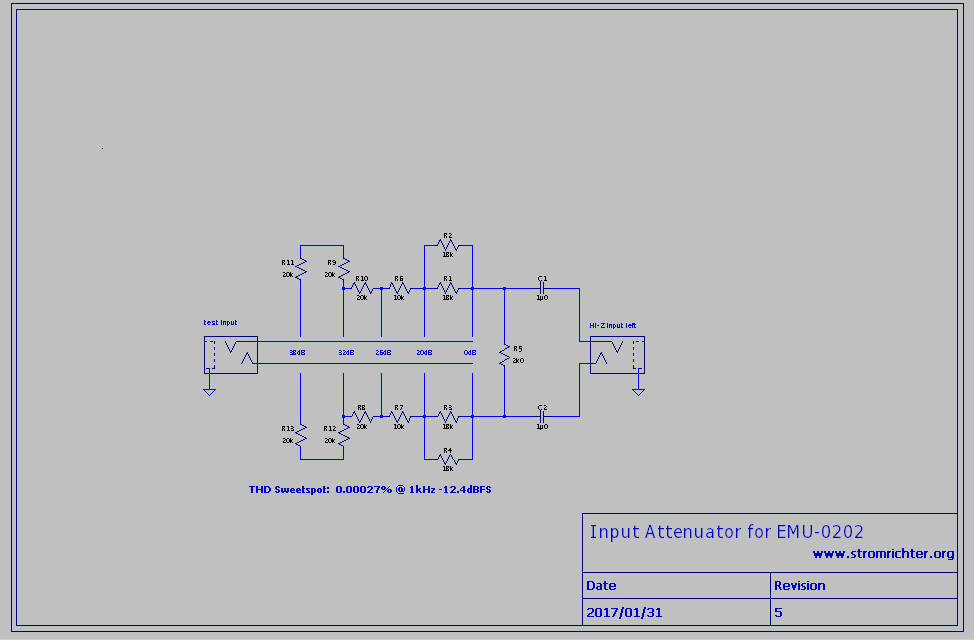
Here is an example of the FFT for the Alpha 20 measured using REW:
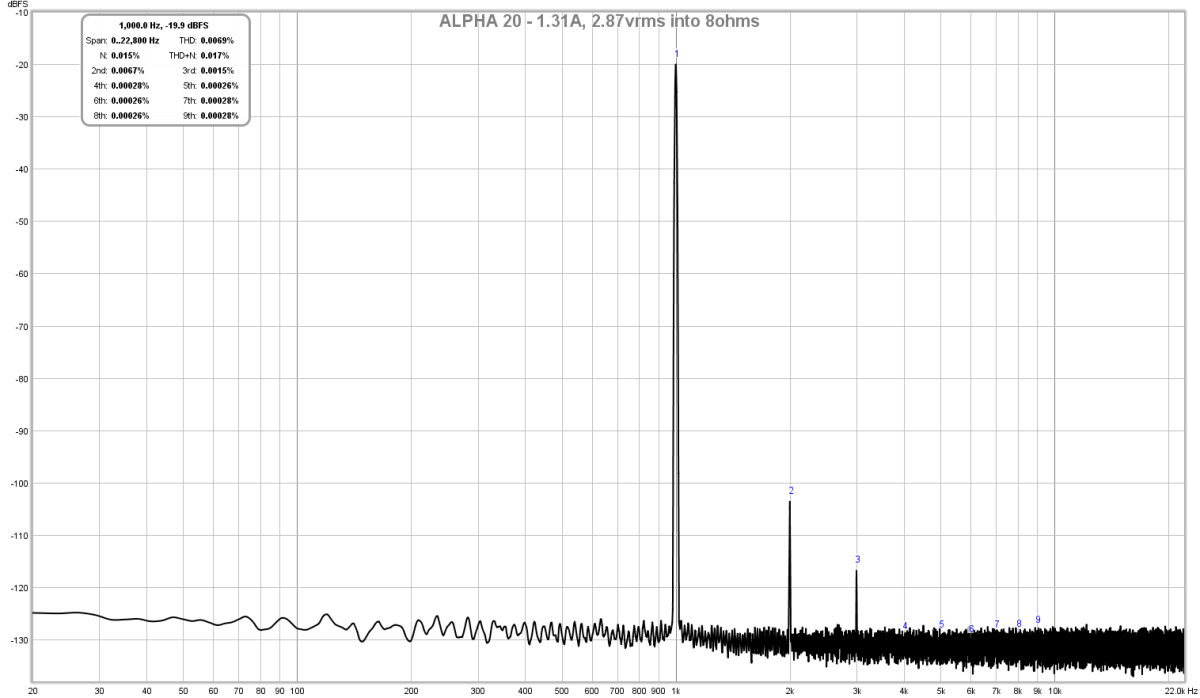
Howto - Distortion Measurements with REW
You might also want to use a balanced input attenuator to reduce noise pickup.
Here is an example of the FFT for the Alpha 20 measured using REW:
I tried balanced input attenuator first - but noise floor was even higher.
Unbalanced one gave better results.
Unbalanced one gave better results.
Ground the shield pin on the balanced cable to your amp “chassis” - the big slab of aluminum that everything is mounted on. That helped reduce a lot of noise on my setup. The other thing that helped was using a battery powered 1kHz oscillator. Not the sound interface’s DAC output. I used either Victor’s low distortion (ppb) oscillator or the Akitika 2pp
1kHz oscillator.
Unplug the laptop and run on batteries.
Remove as much unnecessary cabling near the measurement rig as possible. EMI pickup from nearby mains cables or power cords, etc is sometimes a huge source of noise.
1kHz oscillator.
Unplug the laptop and run on batteries.
Remove as much unnecessary cabling near the measurement rig as possible. EMI pickup from nearby mains cables or power cords, etc is sometimes a huge source of noise.
I used Bonsai's advice and set averaging to 50 samples for each measurements.
Here are new, less noisy graphs for AN:
Here are new, less noisy graphs for AN:
Attachments
Minek,
Thank you for your hard work.
What do you think about these results?
Does the amp sound OK?
Hugh
Thank you for your hard work.
What do you think about these results?
Does the amp sound OK?
Hugh
The amp sounds great.
I measured several amps in the last month - basically most of the amps I built within last 3 years.
Older ones I didn't measure because they were built without oscilloscope and without simulations, so I didn't expect great results anyway.
From these several amps I measured:
1) In listening test I can't tell them apart. They ALL sound the same to my tin ears (same PSU, same speakers, same DAC, same music)
2) as the measured numbers go, the worst was quasi 2n3055 (built for sentimental reasons)
3) another quasi nmos 200 was 2nd worse
4) AN - the simplest amp on this list, and the only class A (and powered by SMPS PSU)
5) All more complex amps: Elvee's amps (circlophone, current_dump), several Unusual amps, Rod Elliot P101, Ian Hegglun's amp, Philips AH578, etc..
Differences between 4) and 5) are minimal. If these results are correct, it doesn't pay off to build more complicated/expensive amps at all.
We all should unplug our soldering guns, and get cheap chip-amps from Ebay. 🙂
That's what my ears, and audio analyzer tell me.
All this chase after certain 'profiles', Thd levels, etc.. does not translate to real-world results. And these tests don't even take into account speakers...
I'm not sure if I'm happy with this conclusion... I would like to be wrong on this...
Maybe QA401 reached its limits? But if that's the case, my ears also reached their limit...
I measured several amps in the last month - basically most of the amps I built within last 3 years.
Older ones I didn't measure because they were built without oscilloscope and without simulations, so I didn't expect great results anyway.
From these several amps I measured:
1) In listening test I can't tell them apart. They ALL sound the same to my tin ears (same PSU, same speakers, same DAC, same music)
2) as the measured numbers go, the worst was quasi 2n3055 (built for sentimental reasons)
3) another quasi nmos 200 was 2nd worse
4) AN - the simplest amp on this list, and the only class A (and powered by SMPS PSU)
5) All more complex amps: Elvee's amps (circlophone, current_dump), several Unusual amps, Rod Elliot P101, Ian Hegglun's amp, Philips AH578, etc..
Differences between 4) and 5) are minimal. If these results are correct, it doesn't pay off to build more complicated/expensive amps at all.
We all should unplug our soldering guns, and get cheap chip-amps from Ebay. 🙂
That's what my ears, and audio analyzer tell me.
All this chase after certain 'profiles', Thd levels, etc.. does not translate to real-world results. And these tests don't even take into account speakers...
I'm not sure if I'm happy with this conclusion... I would like to be wrong on this...
Maybe QA401 reached its limits? But if that's the case, my ears also reached their limit...
Last edited:
minek,
I don't think I can throw in the towel and blame it on your 'tin' ears as you say. The other components of your playback system and particularly your room are very important. I have colleagues who are reaching their 70's and despite having some presbycusis as confirmed by their audiologists, they are clearly able to discern differences in tone, imaging, sound staging, PRAT, etc...amongst dramatically different amplifier designs, from single ended Class A output stages to dramatically more complicated but still excellent sounding Class D designs.
I see the same board certified audiologist every year and get myself tested and I am in my mid 40's. Supposedly I have the hearing of a 5 year old at this time.
The QA401 is a very good spectrum analyzer but is hardly the last word in analyzers. There are differences to be seen with an Audio Precision 555. There is also a difference in price for the analyzer. This is not to mention the differences in a user's knowledge of how to use these analyzers.
I would love to have you over for you to listen to the differences. Sometimes there are elements in the playback setup that are impeding one's ability to discern these differences.
So how about you share with us some context of your system or a picture, that will help. All opinions and impressions are welcome here.
Best,
Anand.
I don't think I can throw in the towel and blame it on your 'tin' ears as you say. The other components of your playback system and particularly your room are very important. I have colleagues who are reaching their 70's and despite having some presbycusis as confirmed by their audiologists, they are clearly able to discern differences in tone, imaging, sound staging, PRAT, etc...amongst dramatically different amplifier designs, from single ended Class A output stages to dramatically more complicated but still excellent sounding Class D designs.
I see the same board certified audiologist every year and get myself tested and I am in my mid 40's. Supposedly I have the hearing of a 5 year old at this time.
The QA401 is a very good spectrum analyzer but is hardly the last word in analyzers. There are differences to be seen with an Audio Precision 555. There is also a difference in price for the analyzer. This is not to mention the differences in a user's knowledge of how to use these analyzers.
I would love to have you over for you to listen to the differences. Sometimes there are elements in the playback setup that are impeding one's ability to discern these differences.
So how about you share with us some context of your system or a picture, that will help. All opinions and impressions are welcome here.
Best,
Anand.
Last edited:
When I say "They ALL sound the same to my tin ears" I'm not 100% correct here.
Let me explain: So I have several amps. I usually rotate them every week or so.
I listen to amp #1, and after a week or two, I say - let's try amp #2. I plug it in, play music, and I say "Man, this one sounds so much better!". And this story repeats itself every time I switch the amps. Every one of them, repeatedly, "sounds the best". So that's why, after going through this cycle for a few years, I say that they all sound the same. The truth is - in a short run - they differ. In a long run - they are of the same quality, and I can't select my favourite from all of them.
It seems like our ears/hearing/brain get used to certain sounds, and we prefer to hear something different/new now and then..
Let me explain: So I have several amps. I usually rotate them every week or so.
I listen to amp #1, and after a week or two, I say - let's try amp #2. I plug it in, play music, and I say "Man, this one sounds so much better!". And this story repeats itself every time I switch the amps. Every one of them, repeatedly, "sounds the best". So that's why, after going through this cycle for a few years, I say that they all sound the same. The truth is - in a short run - they differ. In a long run - they are of the same quality, and I can't select my favourite from all of them.
It seems like our ears/hearing/brain get used to certain sounds, and we prefer to hear something different/new now and then..
Iv'e just checked technical specs of qa401:
Input Noise Floor-113 dBV, 0 dBV input range, inputs shorted, 32K FFT, avg 5, rectangular window, 48kSPS
THD -108.5dB (loopback, single-ended, L-shorted, -2dBV input, 128K FFT, Hann window
I guess that means that whatever is under the noise floor, we can't see/evaluate, right?
I guess that's why all (supposedly) good amps that sim under 150dB, look the same in qa401 plots - all around 120dB...
Input Noise Floor-113 dBV, 0 dBV input range, inputs shorted, 32K FFT, avg 5, rectangular window, 48kSPS
THD -108.5dB (loopback, single-ended, L-shorted, -2dBV input, 128K FFT, Hann window
I guess that means that whatever is under the noise floor, we can't see/evaluate, right?
I guess that's why all (supposedly) good amps that sim under 150dB, look the same in qa401 plots - all around 120dB...
Minek!
The sound depends on many reasons.
1. The quality of the original recording and the intention of the sound engineer.
2. The quality of the audio path is determined by the worst link. In your case, perhaps a loudspeaker. In a broad sense, the technical characteristics, placement, properties of the room.
A good amplifier does not affect the sound. Or it affects only slightly. Therefore, the difference between the amplifiers is insignificant 🙂 Only gross defects are noticeable.
3. You correctly noted that mood, fatigue and other life situations affect. The perception of sound is a physiological but also psychological process. Sound recording and sound reproduction are objectively far from reality, the brain fills in the gaps.
The sound depends on many reasons.
1. The quality of the original recording and the intention of the sound engineer.
2. The quality of the audio path is determined by the worst link. In your case, perhaps a loudspeaker. In a broad sense, the technical characteristics, placement, properties of the room.
A good amplifier does not affect the sound. Or it affects only slightly. Therefore, the difference between the amplifiers is insignificant 🙂 Only gross defects are noticeable.
3. You correctly noted that mood, fatigue and other life situations affect. The perception of sound is a physiological but also psychological process. Sound recording and sound reproduction are objectively far from reality, the brain fills in the gaps.
- Home
- Amplifiers
- Solid State
- Alpha Nirvana 39w 8ohm Class A Amp
